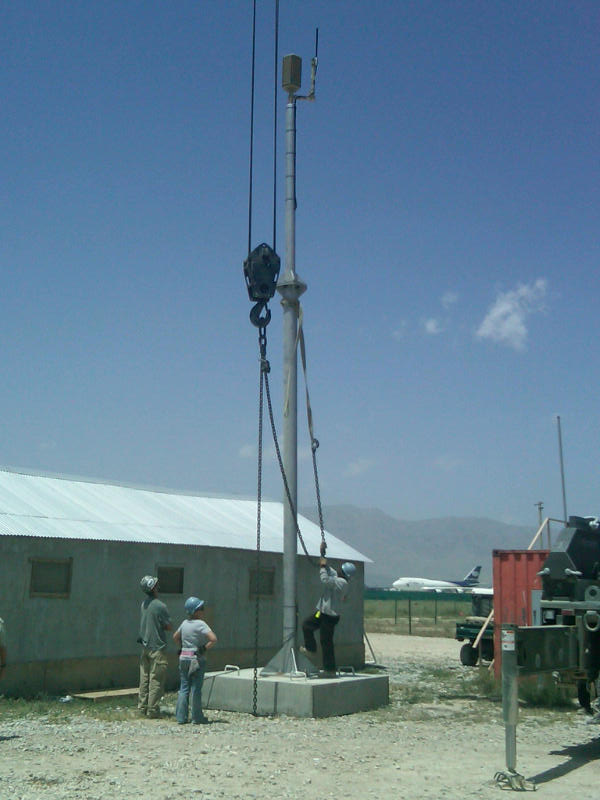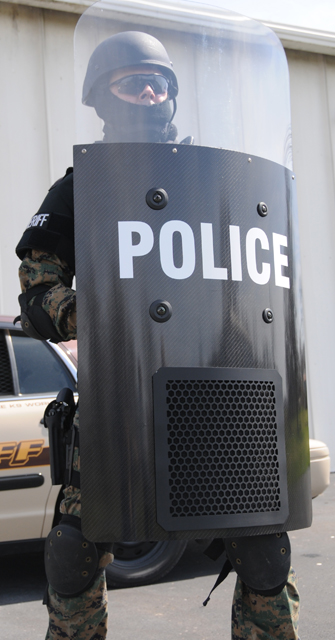Acoustic hailing device on:
[Wikipedia]
[Google]
[Amazon]
 An acoustic hailing device (AHD) is a specialized
An acoustic hailing device (AHD) is a specialized


 An acoustic hailing device (AHD) is a specialized
An acoustic hailing device (AHD) is a specialized loudspeaker
A loudspeaker (commonly referred to as a speaker or speaker driver) is an electroacoustic transducer that converts an electrical audio signal into a corresponding sound. A ''speaker system'', also often simply referred to as a "speaker" or ...
that produces sound at high power for communicating at a distance. AHDs vary in design, output, and usability.
Overview
Acoustic hailing devices are acoustic devices capable of outputting highly intelligible sound at very high volumes. The distance at which acoustic hailing can be effective varies based on several factors including the sound level, directionality, and frequency of the acoustic source, the sensitivity and directionality of the receiver, and the transmission channel environment. The sound level diminishes or attenuates with distance. Consequently, as a general rule, higher source levels have greater range. Acoustic hailing devices can come in two forms; # Directional models: These AHDs are characterized by their ability to create long-range, directional voice communications and warning tones. Their directionality is typically 5° to 60° radius conical at a 2 kHz tone. # Omnidirectional models: These acoustic hailing devices are capable of creating 360° voice communications and warning tones. These devices are capable of being heard over 1.5 miles away from the emitter head.History

Origin
The term ''acoustic hailing device'' came into common use following the suicide attack on the while it was at port in Yemen in 2000. Following this attack, theUnited States Navy
The United States Navy (USN) is the maritime service branch of the United States Armed Forces and one of the eight uniformed services of the United States. It is the largest and most powerful navy in the world, with the estimated tonnage ...
established a requirement for an acoustic hailing device. The intent of this AHD was to provide the Navy with a means to establish the intent of an approaching vessel at a distance such that defensive measures could be taken should the vessel not heed a warning. One unique aspect of this requirement was that the sound needed to be focused so that it could be clearly directed at the approaching vessel.
Present
Since their inception with the introduction of theLong Range Acoustic Device
A long-range acoustic device (LRAD) is an acoustic hailing device (AHD), sound cannon and sonic weapon developed by Genasys. It has been used as a method of crowd control, which has caused permanent hearing damage, having an extremely high ...
(LRAD) in 2002, acoustic hailing devices have grown into a variety of applications. AHD uses include checkpoints, crowd control, maritime shipping, mass notification, early warning systems, critical infrastructure protection
Critical infrastructure protection (CIP) is a concept that relates to the preparedness and response to serious incidents that involve the critical infrastructure of a region or nation.
The American Presidential directive PDD-63 of May 1998 set up ...
, military applications and wildlife protection and control. Acoustic hailing devices are now fielded all over the world by various commercial, law enforcement, and military groups.
Characteristics and measurements
Acoustic hailing devices differentiate from conventional speaker systems in three key ways. Those include volume, clarity, and directionality. Various AHD manufacturers use different methods to measure their products, but a common standard has emerged for each.Volume
Since sound attenuates at a set rate, extremely high outputs are required to cover the vast distances needed. Acoustic hailing devices have an output of 135 decibels (dB) or greater. The acoustic level of the source is commonly expressed in terms of Sound Pressure Level or SPL. SPL is alogarithm
In mathematics, the logarithm is the inverse function to exponentiation. That means the logarithm of a number to the base is the exponent to which must be raised, to produce . For example, since , the ''logarithm base'' 10 of ...
ic measure of the rms sound pressure of a sound relative to a reference value. It is measured in decibels (dB) above a standard reference level. For reference, at a distance of 1 meter, a normal talking voice is approximately 50 dB and a jet engine at 30 meters is 150 dB.
Clarity
A principal weakness of common speaker systems and bullhorns are their clarity. Their horns and cones create sound that is distorted or out of phase. This results in the common “Charlie Brown” effect, where the message is muffled and misunderstood. AHDs create sound that is in phase. Because of this, sound emitted from acoustic hailing devices is intelligible at distance. Clarity is difficult to measure, since it is a subjective reference. However, different scales have been created to compare devices. A common measurement is the Speech Transmission Index (STI). STI ratings range from 0–1.0, with 1.0 being perfect clarity.Focus
AHDs are lastly characterized by directionality. To ensure messages are broadcast to the target, AHDs shape sound into a 30–60° audio beam. This shaping is accomplished through the design of the transducers as well as various reflective horns. The focus of an AHD is typically measured at the frequency of peak directionality. This is typically in the 1–2 kHz range. Not all frequencies of sound are able to be directed equally. Lower frequencies in the bass range are difficult to form. As such, their directionality may be a 40 degree radius or more depending on the design of the AHD.
Use as non-lethal weapons
Acoustic hailing devices have the potential to be used asnon-lethal weapons
Non-lethal weapons, also called nonlethal weapons, less-lethal weapons, less-than-lethal weapons, non-deadly weapons, compliance weapons, or pain-inducing weapons are weapons intended to be less likely to kill a living target than conventional ...
. The human ear can typically stand a sound pressure level of 120 dB before feeling pain. AHDs are capable of 135 dB or more of acoustic energy. The OSHA
OSHA or Osha may refer to:
Work
* Occupational Safety and Health Administration, a federal agency of the United States that regulates workplace safety and health
* Occupational Safety and Health Act (United States) of 1970, a federal law in the Un ...
states that any sound pressure level over 90 dB requires hearing protection. As volume increases so does the chance of hearing loss. The effective non-lethal range of an AHD depends on the total acoustic output of the unit. Typically, this range is 50 meters or less.
See also
* Acoustics *Genasys
Genasys Inc. is based in San Diego, California. Its long-range acoustic device (LRAD) products are used for long-range acoustic hailing and mass notification. The company was previously named American Technology Corporation (ATC) until 2010 and ...
* HyperSpike
* Megaphone
A megaphone, speaking-trumpet, bullhorn, blowhorn, or loudhailer is usually a portable or hand-held, cone-shaped acoustic horn used to amplify a person's voice or other sounds and direct it in a given direction. The sound is introduced int ...
*
References
{{Reflist Loudspeakers Non-lethal weapons